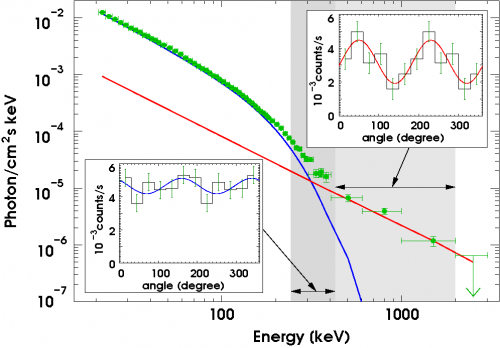Prototype of the X-ray binary systems harboring a black hole, Cygnus X-1 is the subject of many studies since its discovery in the 1960s. By studying its behavior at high energy, an international team led by Philippe Laurent, astrophysicist at the Service d'Astrophysique of the CEA-Irfu and laboratory APC discovered a surprising property of the light emitted by the system, a high degree of polarization. This feature requires a particular organization of the emissive medium and researchers locate this emission at the base of the already observed compact radio jet, close to the horizon of the black hole. This work, based on data collected by the telescope Integral/Ibis, is published in the journal Science Express on 24 March 2011.
Two components, two origins
Consisting of a blue supergiant star in orbit (with a period of 5.6 days) around a ten solar masses black hole, the Cygnus X-1 system belongs to the class of high mass X-ray binaries. It is one of the brightest sources in the X-ray sky, in the Swan (Cygnus) constellation, a region particularly studied by the Integral satellite since its launch in 2002. In fact, Cygnus X-1 was the first source observed by this gamma-ray Observatory.
Scientists have thus collected all the data and obtained an energy distribution (spectrum) between 20 and 2000 keV. Clearly, two components appear. The first, low energy ones (between 20 and 400 keV), is attributed to the scattering of photons of the accretion disk, formed by the material from the companion star caught by the black hole, on a hot plasma of electrons, called the corona, which surrounds the black hole. The origin of the second component, at higher energy, was until now much more enigmatic. To determine its origin, scientists have studied this gamma-ray emission under a particular filter, the polarization. The polarization is a property of light that reflects a particular organization of the emissive medium, including its geometry. To do so, the researchers used the telescope Ibis in a special configuration, the Compton mode, a mode recently applied successfully to the Crab Nebula (see this post for a detailed description of this mode) and gamma-ray bursts. Applying this analysis technique, they discovered that the emission of Cygnus X-1 between 400 and 2000 keV was strongly polarized, contrary to what is observed in this mode at lower energy (250-400 keV). It is the first time that such property is clearly observed at these energies.

Spectral distribution of Cygnus X - 1 (observed points in green, curves of the two components in red and blue) obtained from all the data collected by the telescope Integral/Ibis, in more than 5 million seconds (equivalent to a continuous exposure of 58 days!). At low energy (between 250 and 400 keV, gray box from left) the modulation of the signal that describes the light polarization (curve in the insert), is virtually flat while at higher energy (top right, 400-2000 keV) the signal shows a net modulation, an evidence of a high degree of polarization.
An emission very close to the black hole horizon
A particular organization of the magnetic field is required to obtain such a high degree of polarization, which could be related to an organized jet. Indeed, Cygnus X-1 has a compact jet already detected in the radio band. Photons high energy implies that the emission must occur near the black hole, more precisely close to its horizon. The scientists conclude that the jet itself, responsible for the polarization detected, could be formed very close to the black hole horizon.
Study of polarization at high energy appears therefore as a tool in addition to radio data to study the structure of jets of matter in the vicinity of black holes.
Contact :
Publications :
« Polarized gamma-ray emission from the Galactic black hole Cygnus X-1 »
P. Laurent (1), J. Rodriguez (2), J. Wilms(3), M. Cadolle Bel(4), K. Pottschmidt(5,6), V. Grinberg(3)
(1) CEA/IRFU/Service d’Astrophysique et APC, Paris, (2) CEA/IRFU/Service d’Astrophysique et AIM (CEA/CNRS/Université Paris Diderot), (3) Centre for Astroparticle Physics, Bamberg, Germany, (4) ESAC, Madrid, Spain, (5) CRESST and NASA, USA, (6) Center for Space Science & Technology, Baltimore, USA
Published in Science Express, 2011 March 24 , download the paper pdf format
See also : The ESA press release
Notes :
[1] Light polarization is a property of electromagnetic waves. In this theory, a light wave is characterized by three quantities, an electric field, a magnetic field and a direction of propagation. Electric and magnetic fields are both perpendicular to the direction of propagation. The figure that follows the electric field in space electric field gives the light polarization state. If it is a straight line or an ellipse, we describe it as linear or elliptical polarization, respectively. A linear polarized light has therefore a preferred direction of the electric field. Natural light is not polarized because it is the sum of random waves which mix all electric field directions to the observer. Some media filter the light, transmitting light with electric field oriented according to a certain direction. Polarizing sunglasses allow, for example, reducing reflections on a water pond.
[2] Horizon of a black hole: the horizon of a black hole is defined as the boundary beyond which no body cannot escape, even the light.
Written by : Christian Gouiffès




